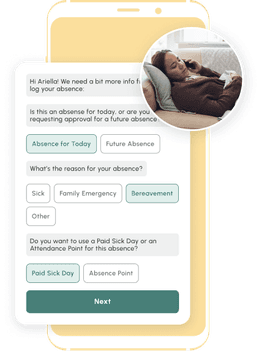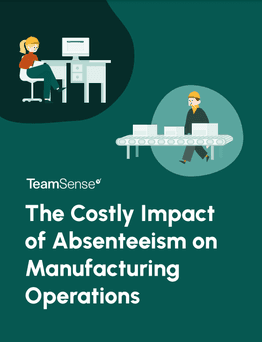Fix the root cause of No-Call No-Show with help from TeamSense
As an HR professional, you probably rely on a variety of tried-and-true HR tools that help you do your job more quickly. But the latest HR apps go beyond simple workflow automation—they’re equipped with artificial intelligence technology that helps you supplement your team’s expertise with enhanced data-driven insights and new gains in efficiency.
Many HR orgs are now using AI applications in HR to support functions including recruiting, employee engagement, performance evaluations, and workforce planning.
Beyond enabling HR teams to get more work done in the same time, such tools can be used to set up customized programs for individual or team needs: Think hiring programs that meet corporate diversity goals, individualized onboarding programs, and customized L&D programs that modify content based on performance, to name a few examples. And the newest generative AI tools can actually build out new content, including policy documents, emails, job descriptions, and presentations—empowering you to enhance your team’s communication strategy and deepen your connection with your workforce.
By gaining AI skills, HR professionals will be able to leverage technology to boost team productivity and generate insights to improve the HR function and heighten employee engagement throughout the organization. You’ll be able to tap into the power of AI to deliver a seamless employee experience, streamline manual labor for yourself and your direct reports, and get enhanced insights on your workforce trends.
In this guide, we’ll help you tackle what you should know about AI-powered tools and their real-world applications, as well as their benefits and challenges.
TL;DR Summary
AI is transforming HR by automating processes and generating valuable insights for recruiting, engagement, and workforce planning. Rather than replacing HR roles, AI serves as a tool to enhance efficiency and decision-making.
Key Takeaways:
AI in HR:
AI-powered tools use machine learning and automation to improve HR functions like recruiting, employee engagement, and compliance.
HR AI Tools:
- Recruiting & Hiring: AI-driven applicant tracking systems (ATS), chatbots, and resume screening tools streamline candidate selection.
- Employee Engagement & Retention: AI-powered pulse surveys, career development recommendations, and recognition programs boost morale and reduce turnover.
- Workforce Planning & Analytics: Predictive analytics help forecast employee burnout, optimize scheduling, and support diversity initiatives.
- HR Administration & Compliance: AI automates payroll, benefits processing, and policy creation to reduce manual errors and improve efficiency.
Adapting to AI in HR:
- Training: Online AI courses (e.g., AIHR, Coursera, LinkedIn Learning) help HR professionals gain essential skills.
- Implementation: Start small by automating repetitive tasks like scheduling before expanding AI’s role in recruitment and compliance.
- Ethical Considerations: AI can inherit biases from training data—HR teams must monitor fairness in hiring and ensure data privacy compliance (e.g., GDPR, CCPA).
The Future of AI in HR:
- More AI-driven personalization in learning, engagement, and career development.
- Enhanced workforce planning with AI-powered analytics for hiring and retention strategies.
- HR’s role shifting to strategic leadership, leveraging AI for decision-making and employee experience improvements.
What is AI in HR?
Understanding AI and Its Role in HR
Artificial intelligence in HR focuses on using machine learning to build algorithms that improve and enhance workflows associated with common HR functions—including recruiting and hiring, onboarding and training, employee engagement and retention, workforce planning and analytics, and HR administration and compliance. By using AI tools for HR management, you can reduce the risk of manual errors, enhance productivity, and tap into improved data insights.
Unlike basic automations used in traditional HR software, which can merely complete repetitive tasks without human intervention, AI tools continually learn from the data that you feed them. That means they can self-adapt over time to become even more effective, and can provide unique insights that help you make better decisions around your business data.
Incorporating AI applications adds value to the HR organization. With the support of AI tools, you’ll be equipped with the insights you need to effectively make decisions and formulate strategies to enhance the workplace experience for all employees.
Key Benefits of AI in HR
What advantages will your department gain by incorporating AI applications for HRM? Some key benefits include:
Increased efficiency
Automate repetitive tasks like scheduling and payroll, helping you save time and reduce the likelihood of manual errors.Better decision-making
Using AI-driven analytics for hiring, retention, and performance can help you evaluate different scenarios to forecast hiring needs and make data-backed assessments.Enhanced employee experience
Incorporate personalized learning, engagement, and career pathing based on each employee’s unique needs and skill set, heightening employee engagement.
AI in Employee Engagement and Retention
The HR team is responsible for the stewardship of a happy, thriving workforce. Ensuring high engagement rates helps you keep morale high and drive improved productivity throughout the organization. Better engagement also translates to higher retention rates, ensuring lower turnover and reduced employee acquisition costs.
Here are some types of apps that will help you facilitate improved engagement and retention:
AI-Powered Pulse Surveys & Sentiment Analysis
Using real-time pulse surveys can help you collect insights on employee attitudes, giving better perspective on trends in morale. Sentiment analysis tools can review all content available about your brand, both in your intranet and in external sites like Glassdoor, to generate insights and recommendations around how to improve the workplace culture.Personalized Career Development Recommendations
Set employees up for success with AI-driven growth plans matched to each team member’s skill set and career ambitions, with personalized training programs and progress assessments.AI-Based Recognition & Rewards Programs
Prioritize building an equitable employee recognition program, with automated performance tracking and analysis that delivers rewards and recognition based on key data metrics rather than peer recognition, avoiding the risk of unconscious bias.
AI in Workforce Planning and Analytics
Building a sustainable workforce depends on having access to data insights that you can use to make strategic business decisions. Some AI app use cases for workforce planning and analytics include:
Predicting Employee Turnover & Burnout
AI analytics tools can be used to assess work patterns and use historic data to predict the likelihood of employee turnover and burnout, with guided recommendations for boosting engagement.Diversity & Inclusion Analytics
Some AI tools are equipped with algorithms focused on reducing bias in hiring and promotions, such as apps that help you optimize your job listings to eliminate gender-biased language to increase applications from women.AI-Optimized Workforce Scheduling
AI-driven scheduling tools can help you boost efficiency in shift-based roles, with options for automated scheduling based on each employee’s availability to maximize efficiency at minimal labor cost, reducing the amount of overtime required.
AI in HR Administration & Compliance
Ready to say goodbye to gruntwork? With AI tools for HR administration and compliance, you can clear your desk of paperwork and streamline many of the common admin tasks that take up your time. These include:
Automating Payroll & Benefits Processing
AI-driven tools for managing payroll and benefits can help you reduce errors, improve efficiency, and enable easier onboarding to ensure employees make use of their benefits.AI for Compliance & Policy Monitoring
Compliance-oriented AI solutions can set up controls to help your organization adhere to labor laws, and provide ongoing risk monitoring and assessment to help you minimize employment labor risk.AI-Driven HR Documentation & Policy Generation
Generative AI applications can be used to help you draft employee handbooks, contracts, employment offer letters, and other policy documents.

No one wants to talk to their boss or a 1-800 stranger to call off. Text changes everything - Reducing No Call No Shows.
Challenges and Ethical Considerations of AI in HR
We’ve covered many valuable use cases for AI applications in HRM—but we don’t recommend going all in on a new technology without first understanding some of the risks and challenges associated with it. Embracing AI applications in your workplace requires a sensitive and balanced approach that effectively navigates these areas of concern.
Bias in AI Algorithms and Fair Hiring Practices
AI applications learn from their training data—so if you’re using a machine learning algorithm that wasn’t trained on a diverse set of data points, the solution is likely going to skew towards hiring policies favoring heavily represented groups rather than underrepresented groups, even if they have the same skill sets. To circumvent these biases, you should be sure to research AI hiring solutions carefully to understand how they address and resolve issues of bias. You can also set benchmarks to ensure gender, racial, and other forms of diversity in your hiring pool, and audit your solution’s hiring recommendations against your benchmark metrics.
Data Privacy & Security Concerns
To work efficiently, AI solutions need access to large amounts of data—much of which may be governed by data privacy regulations, such as GDPR and CCPA. Before handing over your data to an AI tool, it’s important to set strict permission controls, ensuring the solution only has access to the information needed to perform its function. It’s also crucial to ensure that the solution meets high standards for managing data securely: At minimum, any cloud-based AI provider you partner with should have achieved a SOC 2 certificate, which demonstrates compliance with best practices regarding data security.
Balancing AI Automation with the Human Touch
Even as you integrate AI applications with your existing workflows, it’s important to strike the right balance between AI assistance and human-driven activities. Look for opportunities to use AI technology to support your workflows, rather than replace your team’s skills. For instance, you can set up automations for repetitive workflows, but ensure that these task reports are manually audited for inconsistencies and key insights. By leveraging AI tools to help you enhance efficiency and generate new insights from your data, you’ll be able to use them to generate newfound value for your organization and position yourself as a thought leader.

The Costly Impact of Absenteeism on Manufacturing Operations
Learn how chronic, unplanned absenteeism is a costly impediment to manufacturing productivity and efficiency, and how you can reduce absenteeism.
How to Get Started with AI in HR
Choosing the Right AI Tools for Your HR Needs
Rather than adopting AI technology on a piecemeal basis, you’ll be able to streamline your workflows more efficiently by choosing a robust platform that comes equipped with a wide range of AI apps for HRM, tailored to your business size and needs.
For instance, platforms like Workday offer apps that can support you with a broad spectrum of HR functions, including both recruitment automation and ongoing performance management, but may be better suited to enterprise-sized businesses. For smaller businesses, a platform like Gusto can help you with AI-driven payroll, benefits, and compliance management.
Have a large team of frontline, shift-based workers? Using a workforce management solution like TeamSense to help you streamline attendance management and benefits administration can be invaluable. Unlike most HR solutions, TeamSense offers a text-based platform, eliminating the friction of requiring workers to download an app. That results in widespread adoption and better insights on your frontline team’s attendance and engagement.
Training HR Teams to Work with AI
As you start using AI applications in your workplace, and training your own team on best practices, it can be helpful to do some advance training to ensure you feel comfortable with the fundamentals. To that end, consider enrolling in online courses that focus on AI tools, tailored to their use in HR. Both free platforms like Coursera and premium options like AIHR and LinkedIn Learning offer a wide range of expert-taught courses and certificate programs, focusing on helping you gain familiarity with different aspects of AI in the HR field.
Once you’ve become comfortable with the tools you plan to use in your department, it’s time to prepare a smooth transition that will help your HR team adopt the tools without resistance. To that end, set up a series of training workshops to walk through the new technology and give each team member the chance to test it out in a guided, interactive environment. They’ll be free to ask questions, and you can assess their progress with the tools to ensure that they understand proper usage.
Encourage team members who are most comfortable with the technology to guide and support their peers with the onboarding process, starting with smaller initiatives (an AI-based calendar tool) before adopting larger programs, such as an automated recruitment management tool. Keep an open line of dialogue with your team throughout the process, so that you can handle objections, respond to feedback, and ensure a positive experience for all of your employees.
Measuring the Success of AI in HR
Once you’ve started implementing AI tools in your workplace, it’s time to collect metrics to assess the return on your investment. For example, you can evaluate progress in using AI in recruiting by focusing on KPIs including:
Time to Fill – Measures the time between job posting and hiring.
Time to Hire – Tracks the time from when a candidate applies to when they accept the job offer.
Candidate Quality Score – Assesses AI’s effectiveness in shortlisting candidates who perform well in the role.
AI Sourcing Efficiency – Percentage of successful hires recommended by AI vs. traditional methods.
Bias Reduction Score – Evaluates AI’s ability to minimize bias in candidate selection based on demographic analysis.
Where relevant, you can compare these metrics to historical data benchmarks focused on using manual methods to complete recruitment and hiring tasks. Companies often see a dramatic increase in efficiency metrics when using AI HRM tools: For instance, Hilton achieved a 90% decrease in the time required to fill positions with AI-driven recruitment tools.
Even if you’re seeing great ROI from your AI initiatives, it’s important to continually monitor your progress and make improvements to your AI HR strategy. For instance, you should be continually monitoring for the presence of bias in your AI hiring recommendations by using diversity and inclusion benchmarks to assess your AI tools’ impact on the hiring of underrepresented groups, and make adaptations to your AI hiring strategy if these groups are not adequately represented in your candidate pools.
Boosting Efficiency: A 3PL Company Slashes Absenteeism by 39% with TeamSense

TeamSense changed the way this 3PL handled absenteeism, resulting in significant improvement in absenteeism rates, and can help your company too!
The Future of AI in HR
As the HR field gains comfort with AI-driven technology, we’re likely to see more widespread adoption of generative content to quickly develop or adapt training content, policy manuals, and communications materials. HR professionals will also embrace the opportunity to automate common administrative tasks, driving improved productivity and helping them regain time to focus on more strategic initiatives. With these adaptations, we’ll see the HR function grow from a support-oriented role to one of strategic leadership to ensure a sustainable workforce.
If you’re new to exploring the possibilities of AI in your workplace, start small, and see where those changes can take you and your team. By exploring AI-powered tools like TeamSense for workforce management, you’ll be able to quickly see the benefits of streamlined, automated leave management and attendance-taking processes; self-service chatbots for employee benefits administration; and enhanced attendance workforce data insights to optimize operational efficiency and lower workforce costs.
Ready to get started? Try out a demo of TeamSense today.
About the Author

Jackie Jones, Employee Engagement & Attendance Specialist
Jackie Jones has over three years of experience helping HR teams improve employee morale, reduce absenteeism, and create happier, more engaged workplaces. With a strong background in employee relations and attendance management, she brings practical strategies and insights that support frontline teams and the HR professionals who lead them.


